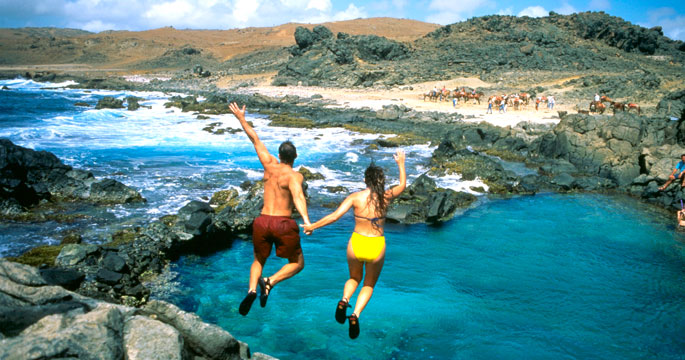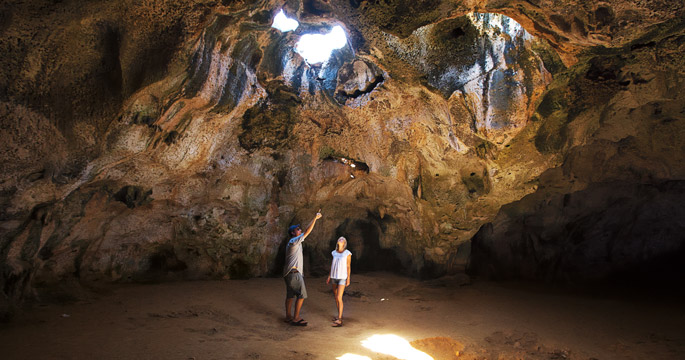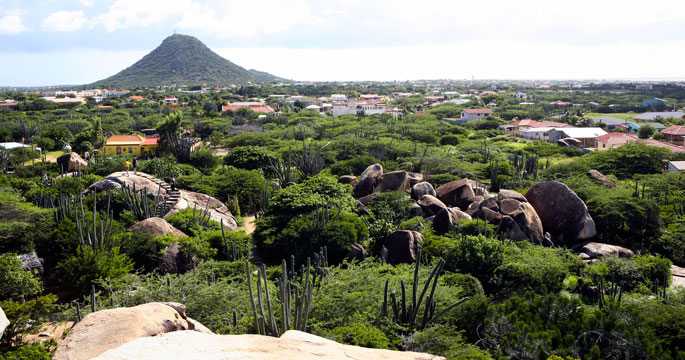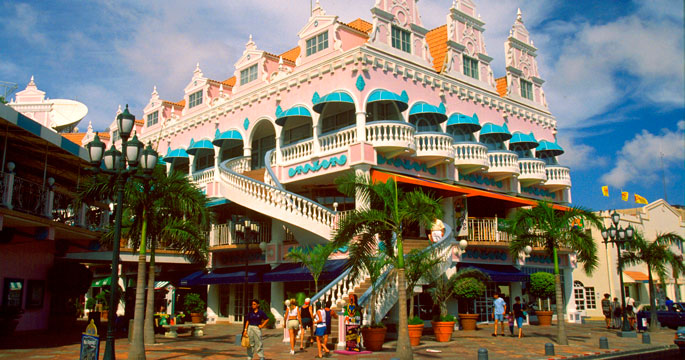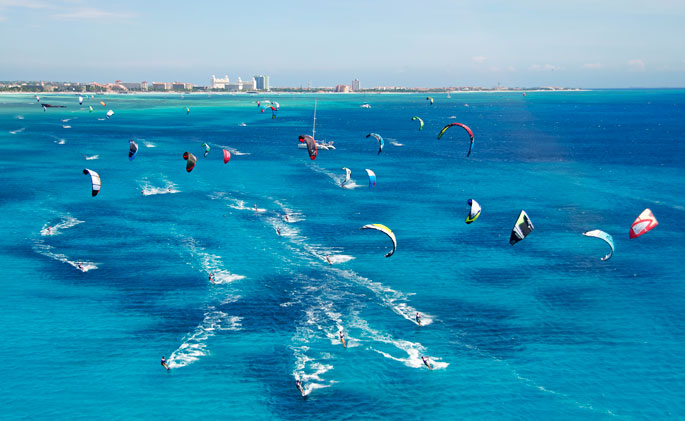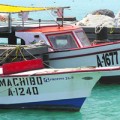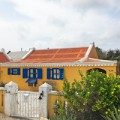Vacationers are lured by visions of expansive swaths of sand, bright waters, casual beach culture and a smorgasbord of water sports. Aruba delivers on these promises, but there’s more to this island beyond the sun and fun. Better than half of all visitors come back, and many form lasting bonds and friendships with locals. It’s not uncommon to find folks who return twice a year for periods of a month or more; many have been coming to Aruba for decades. The island does it right, and it all starts with the people. The Aruba license plate states “One Happy Island,” which is not just a motto, but an integral element of the local atmosphere.
1 Mixing Zone
Though officially part of the Netherlands, Aruba is home to a wide range of cultures and ethnic groups, some dating from the days of the Dutch Caribbean trade, others more recent arrivals. Dutch overtones are evident, but so too are Caribbean and South American influences. Adding to the mix, you may find an artist from Spain, a yoga instructor from Norway and a chef from Italy. Over the centuries, each nation has brought a bit of their homeland culture, which can be seen in the island’s food, drink, dance and art. Native Arubans, descendents of the Arawak, are sprinkled with a dash of Dutch, Spanish and African that blends into a rich cultural mix.
2 International Markets
Aruba’s well-stocked supermarkets turn grocery shopping into an international affair. Much like the island’s diverse population, store shelves are stocked with an eclectic range of products from around the world. Take home one of Europe’s finest coffees, Douwe Egberts, and tins of almond windmill cookies from Holland. South America contributes Cacique rum and Harina P.A.N. cornmeal for making Venezuelan arepas. A bounty of sauces, condiments and spices come from Asian distributors, sharing shelf space with favorite North American brands.
3 Drink All You Want
Rather than rely on rainfall or limited and sometimes brackish groundwater reserves, Aruba gets ample supplies of fresh, coral- filtered drinking water from a state of the art desalinization plant in Oranjestad. The island is quite proud of its taste, and it flows from taps in generous and safe-to-drink quantities. Now, this pure water has also become a key ingredient in a local beer: Balashi. The island brew has edged out sister island Curacao’s Amstel as the local beer of choice.
4 Going Coastal
Aruba’s calm west coast is flanked by miles of magnificent beaches, and at the center of the action is Palm Beach, the Aruban equivalent of Copacabana. This stretch of sand is home to the island’s finest resorts and is a playground for water sports, beach activities and plenty of people watching. Whether it’s spending the day lazing in a chaise, bobbing on a float or napping under a shaded palapa, everyone makes it to Palm Beach at one time or another. Closer to town, lower-key Eagle Beach is a favorite with families, who come to play in banks of soft sugary granules and frolic in small pale turquoise waves.
5 Dry Land Adventures
More than 20 percent of Aruba lies within Arikok National Park. Located along the island’s northern shore, this 13-square-mile preserve resembles an arid Arizona landscape, with intriguing rock formations, caverns and giant cacti. Explorations can take place on foot, via horseback or by car. In addition to ancient Arawak petroglyphs, there are caves to be discovered along with pocket- size beaches and tidal pools tucked into coves that protect waders from the pounding surf. Wildlife includes donkeys, lizards, burrowing owls and the occasional rattlesnake.
6 On the Waterfront
Most everyone who visits Aruba takes in some water-based activity, even if it’s just a snorkel from the beach or a sunset sail. The steady trade winds that blow from the east made the island an early mecca for the sport of windsurfing, and kiteboarders have since joined in. In more sheltered waters, where hotels block the wind, conditions are ideal to paddle a kayak or take a yoga class on a SUP. And just offshore, coral reefs and shipwrecks beckon divers and snorkelers.
7 A Diverse Palate
The island’s 200-plus eateries are known for serving up a medley of international cuisines. Dutch, French, Belgium, Chinese, Italian and Thai dishes are favorites, but don’t pass up the opportunity to try local recipes like keshi yena—a ball of Gouda or Edam cheese filled with spiced chicken or beef, tomatoes, onions, olives, green pepper and raisins. Pastechi, an empanada filled with chicken, beef or fish, is a favorite grab-and-go snack from markets and bakeries. Dutch and Indonesian influences come together in another local pairing: chicken satay with peanut sauce, served with French fries and mayo.
8 Lady Luck
Casinos are big on the island, and just about every large resort has its own. The tables at the Hyatt Regency Casino, the Marriott Stellaris Casino and the Radisson on Palm Beach are busy day and night. In town you can try your luck at the Seaport Casino and spend your winnings at the shops, restaurants and bars right there. One of the island’s first—now rebuilt bigger and better—is the Alhambra Casino, with its own shopping and dining arcade. Operated by the Divi Group and close to its resort locations on Eagle Beach, this casino even provides complimentary transportation via golf carts, so carrying all that loot is never a burden.
9 After Hours
When the sun goes down, Aruba parties on. There is no shortage of nighttime activities both in Palm Beach and downtown Oranjestad, where you’ll find the best action including rooftop dancing and ocean views from the Local Store bar. Mojito’s Cantina & Grill at the Royal Plaza Mall pulls in the Latin lovers who gravitate toward salsa and bachata, and at the Grand Café Tropical in Renaissance Marketplace, dance tunes dominate the scene. The hotel zone is ideal for a nightcap at places such as MooMba Beach Bar & Restaurant, which sits under a massive palapa right on the sand. If your night takes you no farther than Palm Beach, several clubs and bars are within walking distance of many hotels.
10 Artistic Impressions
For a small island, Aruba has a burgeoning art community, with locally grown talent. Inspiration often comes from nature, but exposure to global art and ideas has influenced both technique and medium. You’ll find sculptors, potters and painters; some portray the local landscape while other offer subtle social and environmental messages. A variety of work is showcased at three primary galleries: Gasparito Restaurant & Art Gallery, Insights Art Studio and long-time favorite Que Pasa Restaurant, Art Gallery & Bar. Exhibitions can also be viewed at the Marriott and Westin resorts on Palm Beach.

